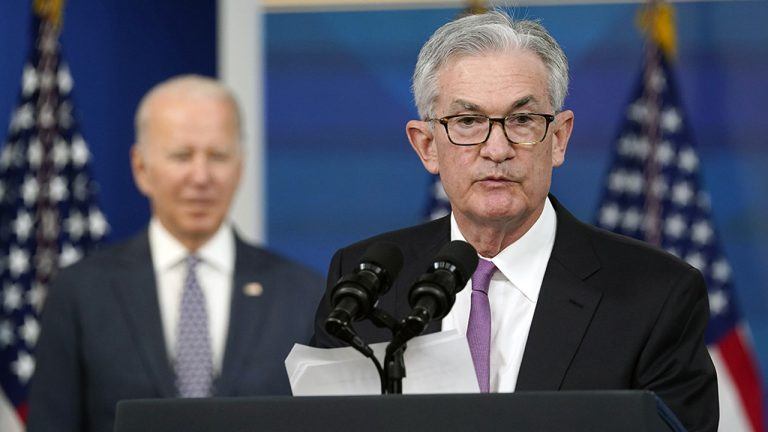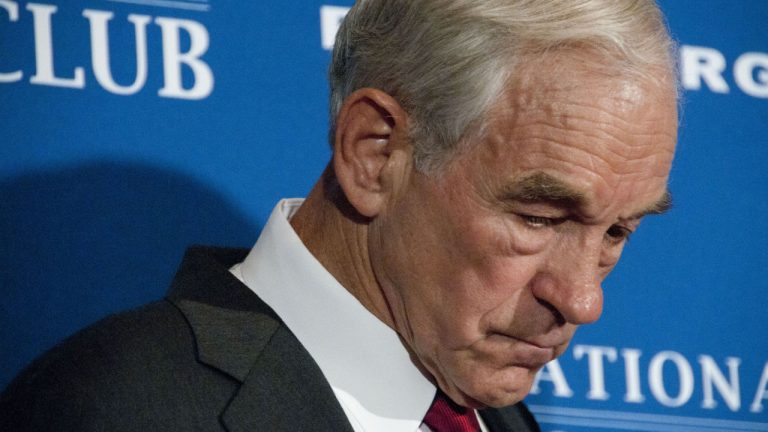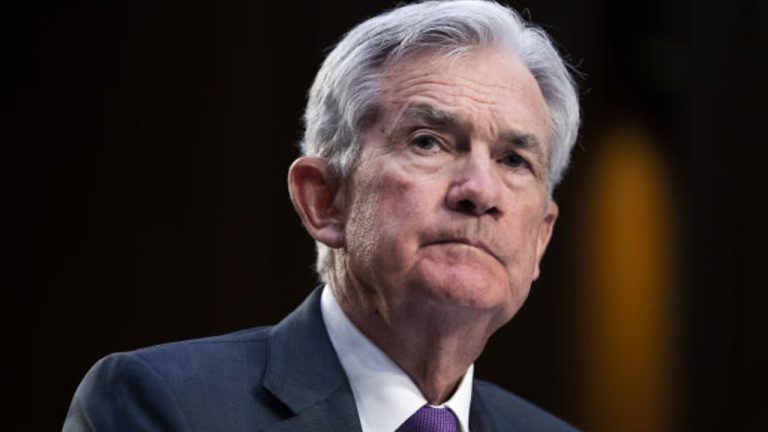 Thomas Joseph Webster, Professor Emeritus of Economics at Pace University, challenges the long-held belief in the Federal Reserve’s political independence in his comprehensive report, “The Myth of Fed Political Independence.” Webster’s research scrutinizes the relationship between fiscal and monetary policies, arguing that the Federal Reserve operates more as a political tool than an independent entity. […]
Thomas Joseph Webster, Professor Emeritus of Economics at Pace University, challenges the long-held belief in the Federal Reserve’s political independence in his comprehensive report, “The Myth of Fed Political Independence.” Webster’s research scrutinizes the relationship between fiscal and monetary policies, arguing that the Federal Reserve operates more as a political tool than an independent entity. […]
Analysts recently debated whether or not the Bitcoin halving is still a meaningful catalyst for BTC’s price discovery.
A recent panel at the Swan Pacific Bitcoin festival was cleverly titled, “Are halving price cycles bullshit?” Throughout the discussion, host and founder of the Bitcoin Layer Nik Bhatia asked Marathon Digital CEO Fred Thiel, Swan CIO Ralph Zagury and Swan product manager Andy Edstrom to share their thoughts on whether the Bitcoin halving is truly a bullish event or just another narrative that novice investors buy into.
While the panel’s headline might be offputting for some, the inquiry is of great interest to all manner of Bitcoin (BTC) and cryptocurrency investors. The conventional belief held by many in the space is that the Bitcoin supply halving is a bullish phenomenon that when complete, is followed by near parabolic upside in BTC price.
Go and ask any Bitcoin lover about what they’re most excited about in the next year and if they don’t mention the chance for a spot Bitcoin ETF approval first, they're probably going to say the upcoming halving event.
Previous Bitcoin halving events have coincided with bull markets ramping up.
— ecoinometrics (@ecoinometrics) September 6, 2023
But will the macro conditions be ripe for that next year in May?
~ If we are past the initial shock of a recession.
~ If a spot BTC ETF is approved.
~ If QE is back on the menu.
Then the planets will… pic.twitter.com/g5dEEKiSMF
While previous performance does provide some compelling evidence for what might happen in the next halving, questioning long held assertions and price expectations for a high volatility asset like Bitcoin is probably something every investor should do more often — especially when considering the number of bearish events that have occurred in the past two years.
To start the discussion, host Nik Bhatia jumped right in by asking “if the halving is the main driver of the Bitcoin price?”
Thiel quickly responded with:
“In this cycle, no, I think it’s liquidity”
Zagury agreed, adding that “flow is really what drives the market, so the halving by definition, there’s nothing on it that should impact price.” Interestingly, Edstrom took a different position by suggesting that:
“I think the halving is still bullish and we can debate what the magnitude of that effect is, but yeah, I think it still matters for price.”
Each panelist, including host Bhatia seemed to agree that while the halving may possess some market moving capacity, it could be diminishing over time. According to Bhatia,
“The halving affects supply. It is less and less material as time goes on and it does nothing to affect demand. But from a psychological perspective, we might be able to play devil’s advocate.”

Speculation is essentially at the root of all investing, and while Zagury and Thiel are of the mind that investors attribute more hope, than fact, to the forecast impact of the Bitcoin halving, Edstrom sees the event as the manifestation of a “psychological feedback loop coming into the demand side.”
“We think that Bitcoin price is going to be higher in the future, and by extension we are applying a lens of investment as we’re investing in Bitcoin.”
Another popular yearslong held belief by many investors is the role derivatives play in Bitcoin’s price discovery. Bhatia asked whether derivatives played a larger role than spot trading in impacting Bitcoin’s price action and Zagury said,
“The reality is that the data points we have, in terms of halving, are not enough to come to any conclusion. If you look historically at Bitcoin price, we’ve got the whole data set of price, and you try to find patterns of distribution, of how returns actually work, very quickly you see that there’s a lot of outer correlation, which means that price depends on time and also past performance.”
According to Zagury, “a thing about Bitcoin which is super curious, and I think there isn’t any other asset class like this out there, is that most of the time, Bitcoin is moving either sideways, in terms of number of days, it's either sideways or down.”
Related: BTC price models hint at $130K target after 2024 Bitcoin halving
Bitcoin’s time spent trading in a rangebound band or in a downtrend is what Zagury says “makes it really hard to hodl, right, because it means you're going to have months and years of pain and you’re going to have days of glory.”
“Being a hodler by definition, by distribution of prices that you see historically, it's extremely hard.”
Peddling back to the initial question about the role derivatives play in Bitcoin price discovery, Zagury said:
“When we talk about derivatives, the first thing you’re going to talk about is probability. It’s impossible to conclude what is really going to happen with Bitcoin price, that’s the first thing that you conclude by looking at historical returns. Going back to the halving, the fact that it actually outer correlates a lot, sometimes, in particular times of low liquidity. A small move that bumps the price up, the marginal seller out there will go through the short term sellers and then the price will jump up significantly. This explains why price moves up very very quickly.”
Despite discounting the impact of Bitcoin supply halvings on BTC price, each panelist expressed their positive longer-term bullish perspectives for Bitcoin’s value.
With liquidity being the agreed upon future price catalyst for Bitcoin, Zagury said:
“I’m very bullish. I think we are going to see that soon, because liquidity has been drawing down and we see that these things are starting to happen and it's not going to take a lot for us to see a very big move.”
When asked when and how this all-important liquidity comes back, Edstrom hinted that 10-year U.S. Treasuries pushing above 5%, the potential regional bank failures that mirror the ones seen 6 months ago, and the rising amount of banks holding long duration government debt at a loss, are all signs that a Federal Reserve pivot that returns to quantitative easing could occur sooner than later.
This article does not contain investment advice or recommendations. Every investment and trading move involves risk, and readers should conduct their own research when making a decision.

Quantitative easing is a monetary policy tool where a central bank purchases financial assets to increase the money supply and stimulate economic activity.
Although quantitative easing can be a useful tool in times of economic crisis, it is often criticized for its potential drawbacks, which include escalating inequality, distorting markets and possibly laying the groundwork for future financial instability.
Benefits from QE frequently accrue to asset owners, especially the wealthy who own financial assets such as stocks and bonds. Due to the fact that it may not always result in fair economic growth or be advantageous to a larger population, this can worsen income disparity.
Additionally, the increase in liquidity brought on by QE has the potential to fuel excessive speculation and asset bubbles in the financial markets, potentially driving up prices for stocks, homes and other assets to unsustainable levels. Furthermore, higher volatility in the cryptocurrency markets could result from increased liquidity from QE, making them less appealing to traditional investors.
The effects of QE on inflation and real economic growth may be modest. In times of uncertainty or when interest rates are already very low, it may fail to significantly increase consumer spending or business investment.
Moreover, QE can impair the proper operation of financial markets by artificially lowering interest rates and distorting the yield curve, making it more difficult for investors to appropriately assess risk and allocate resources effectively.
When central banks rely too heavily on unorthodox monetary measures like QE, their effectiveness may eventually decline, leaving fewer tools available to address future economic challenges. Last but not least, QE may result in a weaker currency, which could raise issues with global trade imbalances and competitive currency devaluation.
The opposite of QE, known as QT, involves central banks selling assets to reduce the money supply and possibly raise interest rates. QT may result in less liquidity on financial markets, which may impact the value of cryptocurrencies.
Some key differences between QE and QT are stated in the table below:

It’s important to emphasize that the effects of policies such as QE and QT are not fixed; they can fluctuate depending on unique economic circumstances and the timing of their execution.
Through broader market dynamics, quantitative easing may have an indirect impact on cryptocurrencies.
Traditional banking systems’ quantitative easing may have unintended consequences for cryptocurrencies. When central banks participate in quantitative easing, they may lower interest rates and devalue fiat currencies by injecting money into the economy.
Some investors may turn to alternative stores of value, such as cryptocurrencies, in light of greater liquidity and diminished purchasing power for traditional assets. As a result, the demand for cryptocurrencies like Bitcoin would rise, potentially pushing up their values. However, such a scenario doesn’t directly result from QE’s mechanisms but rather from investors’ reactions to the economic conditions influenced by quantitative easing.
However, as mentioned, cryptocurrencies function in a unique ecosystem that is influenced by forces other than conventional monetary policy. Other factors that affect their worth include market sentiment, regulatory changes, technological improvements and adoption patterns.
The interaction between conventional financial markets and the distinctive features of digital assets makes QE’s effect on cryptocurrencies complex and multifaceted.
QE is a central bank’s strategy of injecting money into its economy by buying assets to lower interest rates and boost economic activity.
The authority to engage in QE as part of its monetary policy tools is granted to central banks like the Federal Reserve in the U.S., the European Central Bank or the Bank of Japan. These central banks make strategic efforts to boost the economy when more conventional policies, such as interest rate adjustments, are less successful.
There are various steps involved in this process. First, the central bank determines the economic circumstances that call for QE, which frequently occur during recessions or times of low inflation. Once a decision has been made, the central bank declares its intention to purchase financial assets, such as equities or bonds, from the market.
By doing this, the bank raises interest rates and stimulates demand for these assets, which in turn drives up their prices. The central bank generates new money digitally to enable these purchases, which it then uses to pay the sellers, often banks or financial institutions. As a result, the economy’s money supply grows. The increased availability of funds may boost borrowing, investing and spending.
QE aims to stimulate economies by boosting the money supply and lowering long-term interest rates. When conventional monetary policies are insufficient, they promote lending, investment and expenditure to enhance growth while reducing deflationary pressures.
Although there are parallels between some measures taken in the world of cryptocurrencies and the consequences of quantitative easing, it is difficult to directly apply conventional ideas of monetary policy to cryptocurrencies due to their decentralized nature.
In contrast to traditional financial systems, the idea of QE does not apply directly to the world of cryptocurrencies. Cryptocurrencies, such as Bitcoin (BTC) and Ether (ETH), run on decentralized networks and are not regulated by governments or central banks. As a result, no one institution can implement conventional monetary policy measures like quantitative easing in the crypto industry.
However, there are some potential implications to consider:
Traditional quantitative easing involves central banks buying financial assets to raise the money supply. In the world of cryptocurrencies, some cryptocurrencies, such as BTC, which has a fixed supply of 21 million coins, have set or capped supplies. Thus, there are differences in supply dynamics. These coins don’t produce new units; therefore, hodlers may see swings in value owing to supply constraints.
In the cryptocurrency world, there are situations where new tokens are handed to existing hodlers, similar to a central bank’s quantitative easing program in that it expands the quantity of tokens. QE-like distributional effects can be produced through forks and airdrops, but they frequently arise from technical developments or community decisions rather than from deliberate monetary policy.
Some stablecoins could theoretically be used in ways similar to QE. For instance, if a stablecoin issuer were to create more stablecoins backed by additional collateral, it could resemble an expansion of the money supply. Stablecoins are often tied to real-world assets; thus, this isn’t precisely the same as QE.
Due to a variety of reasons, including market sentiment, technological breakthroughs, regulatory developments and macroeconomic trends, cryptocurrency markets may see price gains or reductions. Sometimes, these price changes might be compared to how monetary policy affects conventional assets.
Quantitative easing entails the central bank acquiring financial assets off the market, such as government bonds.
When interest rates are low and conventional measures are less successful, central banks use the monetary policy tool known as quantitative easing (QE) to boost the economy. The central bank initiates QE by acquiring financial assets from business banks, financial institutions and, occasionally, the open market. Government bonds are the most commonly bought assets, but central banks can also purchase corporate bonds or mortgage-backed securities.
The central bank issues new currency to cover the cost of these purchases. As a result, the economy has more money available. The freshly produced money is given to the asset sellers, which are often banks, in exchange for the assets they sell to the central bank.
The central bank raises demand for assets by purchasing significant amounts of them, particularly government bonds. As a result, these assets become more expensive, and, in turn, their yields or interest rates decline. Lower long-term interest rates stimulate spending and borrowing, as well as stock and real estate investments in riskier assets.
The United States Federal Reserve implemented quantitative easing to amplify the money supply and invigorate economic expansion, addressing the repercussions of the COVID-19 pandemic’s impact. As a result, the Federal Reserve’s balance sheet surged to approximately $8.24 trillion (as purchased assets were added to the central bank’s balance sheet).
One of the key concerns with QE is its potential impact on inflation. A considerable infusion of cash into the economy could result in price increases if the growth of products and services is outpaced by the expansion of the money supply. However, this risk depends on a number of variables, including the overall health of the economy, consumer and business trends, and the central bank’s capacity to successfully control the money supply.
 Former House Representative Ron Paul has presented his stance when it comes to the financial crisis that the U.S. is currently facing. Paul stated that the continued application of quantitative easing (QE), a policy used to increase the money supply, and the decades of almost null interest rates, are what nurtured the current financial crisis […]
Former House Representative Ron Paul has presented his stance when it comes to the financial crisis that the U.S. is currently facing. Paul stated that the continued application of quantitative easing (QE), a policy used to increase the money supply, and the decades of almost null interest rates, are what nurtured the current financial crisis […]
A political deadlock over the U.S. debt ceiling and its potential impact on the price of Bitcoin, which is already up 75% in 2023.
On April 26, House Republicans scarcely passed their bill to increase the U.S. debt ceiling. This led to analysts already weighing its potential impact on the price of Bitcoin (BTC), ranging from extremely bearish to overly bullish.
Ultimately, U.S. dollar liquidity is the key to both of these opposing viewpoint.
Some analysts, including Jesse Meyers, the COO of investment firm Onramp, believe raising the debt ceiling would prompt the Federal Reserve to print more money, thus boosting capital inflows into "risky" assets like Bitcoin.

The debt ceiling represents the maximum amount of money the U.S. government can borrow to pay its bills.
Related: Fed balance sheet adds $393B in two weeks — Will this send Bitcoin price to $40K?
Raising it means they can issue more debt to generate more capital. But since the Fed is not buying bonds anymore thanks to its "quantitative tightening," and the flow of available M2 money supply crashing, the U.S. government debt may find it hard to attract buyers.

In other words, a deflationary recession that Meyers believes will force the Fed to return to its quantitive easing policy.
"When the debt ceiling is lifted and credit-contraction leads to economic crisis... They will have to print money on a massive scale," he noted, reminding:
"Bitcoin was the winner during the last round of stimulus."

The government has already hit its $31.4 trillion debt ceiling in January 2023. So, it theoretically cannot generate more capital until the Senate passes the House-passed bill.

However, it's unlikely to pass the Senate and Biden has also vowed to veto the bill.
The standoff could result in the U.S. government defaulting on its debt in June, which poses negative consequences for the U.S. dollar, according to Jeff John Roberts, crypto editor at Fortune.
"If [Republicans] decide to go the kamikaze route during the current debt ceiling standoff, it will deliver another major hit to the dollar's credibility—and a further boost to Bitcoin," he noted.
Former U.S. Treasury Secretary Lawrence Summers meanwhile downplays the fears associated with a potential debt default, noting that the odds of it happening stands under 2%.
Summers:
"I think the odds that we will default in the sense of insolvency, and over some interval people who hold bonds will not be able to get paid, are - assuming the absence of a major war - certainly under 2% over the next decade."
Presenting a similar outlook, analyst TedTalksMacro says extending the debt ceiling would ensure that the Fed continues contracting its balance sheet through the ongoing QT.
That points to lower liquidity and, in turn, more downside pressure for Bitcoin.
"One caveat to the liquidity down/sideways for the rest of 2023 would be the Fed winding up or slowing the current pace QT," TedTalksMacro adds.
This article does not contain investment advice or recommendations. Every investment and trading move involves risk, and readers should conduct their own research when making a decision.

The U.S. central bank's liabilities may increase if more regional banks fail, creating an upside scenario for the price of Bitcoin.
As of March 22, the Fed's balance sheet surged by nearly $94.5 billion — a $297 billion increase from the last week when the banking crisis started.
Overall, the U.S. central bank's liabilities increased by $393 billion in the last two weeks to $8.734 trillion. That is closer to the all-time high of $8.95 trillion a year ago when the Fed started its quantitative tightening program and reduced its assets by $600 billion.

The Fed released the data on March 23, coinciding with Bitcoin (BTC) price rallying 5.5% toward $29,000. The rise occurred amid speculations that the Fed's expanding balance sheet results from quantitative easing (QE).

But the Fed did not use new dollar reserves to purchase long-term treasuries. Instead, the central bank dropped its U.S. Treasury holdings by $3.5 billion to $7.937 trillion, suggesting that quantitative tightening is still in place to curb inflation.
On the other hand, Fed's balance sheet grew because it dispatched short-term loans to the ailing banking sector.
Notably, as of March 22, the Fed slashed the usage of its "discount window," which helps commercial banks manage short-term liquidity needs, by $42 billion. Instead, it allocated the same $42 billion to its brand new Bank Term Funding Program (BTFP).

The other $60 billion went to the Fed's swaps facility that provides liquidity to offshore banks.

The Fed's tightening policy and lending facilities to regional and offshore banks risk drying up cash liquidity. This may boost the dollar's valuation versus other top foreign currencies, which, in turn, could push Bitcoin's price lower in the short term.
Interestingly, the U.S. dollar index has gained 1.5% since the Fed's balance sheet update.

The ongoing credit crisis may not have peaked despite Fed's $393 billion emergency lending to banks, however, if one considers Janet Yellen's blurred outlook on depositors' insurance.
On March 21, the U.S. Treasury Secretary confirmed protecting uninsured depositors over $250,000 "if smaller institutions suffer deposit runs" such as those witnessed in Silicon Valley Bank and Signature Bank.
But Yellen did a U-turn the next day in her statements to the Senate that she had not considered “blanket insurance or guarantees of deposits.” The bank stocks tanked in response to her statement, resulting in another U-turn.

Yellen then told the House on March 23 that the authorities "would be prepared to take additional actions if warranted."
Janet Yellen is too old, incompetent or a liar.
— The Wolf Of All Streets (@scottmelker) March 23, 2023
Choose your poison. https://t.co/Vy8CJZm2x1
In any case, the market will need to wait for the balance sheet data next week to determine whether or not the Fed's liabilities are declining.
But if these emergency lending facilities keep rising after more bank collapses, then QE will be inevitable, similar to what happened after the 2008 global financial crisis.
“The return of (stealth) QE via the BTFP and opening of daily Swap Lines with friendly foreign Central Banks clearly signals that sovereign debt will be monetized and currencies will be further debased. The endgame is now undeniable.” https://t.co/s5enNAJCZi
— Balaji (@balajis) March 24, 2023
An expanding balance sheet — with or without QE — has proven bullish for Bitcoin in the past. This correlation will continue if the banking crisis deepens, according to Stack Hodler, the author of crypto-focused Stack Macro newsletter.

"BTFP, Swap Lines, TPI - It's All QE," the analyst noted, adding:
"It all leads to balance sheet expansion and fiat currency dilution despite plenty of Central Bank fans that will tell you otherwise."
From a technical perspective, Bitcoin price is well-positioned for a run-up toward $40,000 by June, or 50% higher from today's price.

As illustrated above, the upside target originates from Bitcoin's inverse-head-and-shoulders (IH&S) breakout setup on the weekly chart.
This article does not contain investment advice or recommendations. Every investment and trading move involves risk, and readers should conduct their own research when making a decision.
 Following the fallout over the past two weeks in the U.S. banking industry, the Federal Reserve raised the federal funds rate by 25 basis points (bps) on Wednesday, citing the need for the inflation rate to return to 2% over the long run. Fed Raises Rate Despite Calamity in the U.S. Banking Sector It’s been […]
Following the fallout over the past two weeks in the U.S. banking industry, the Federal Reserve raised the federal funds rate by 25 basis points (bps) on Wednesday, citing the need for the inflation rate to return to 2% over the long run. Fed Raises Rate Despite Calamity in the U.S. Banking Sector It’s been […] At around 7:30 a.m. ET, the price of bitcoin skyrocketed past the $27,000 range to a high of $27,025 per unit. Precious metals, or PMs, like gold and silver, also rose between 1.98% and 2.12% against the U.S. dollar over the past day. While many market observers are wondering why specific assets like PMs and […]
At around 7:30 a.m. ET, the price of bitcoin skyrocketed past the $27,000 range to a high of $27,025 per unit. Precious metals, or PMs, like gold and silver, also rose between 1.98% and 2.12% against the U.S. dollar over the past day. While many market observers are wondering why specific assets like PMs and […] The U.S. Federal Reserve has raised the benchmark bank rate seven times during the course of 2022, leading many to question when the central bank will cease or change course. The Fed has stated that it aims to bring inflation down to the 2% target, and the increases to the federal funds rate are intended […]
The U.S. Federal Reserve has raised the benchmark bank rate seven times during the course of 2022, leading many to question when the central bank will cease or change course. The Fed has stated that it aims to bring inflation down to the 2% target, and the increases to the federal funds rate are intended […]
Bitcoin is working as a hedge against inflation despite its 2022 weak price performance, says Steven Lubka, managing director of private clients at Swan Bitcoin.
While Bitcoin (BTC) has failed in countering this year's rampant global inflation, it should still be considered as an inflation hedge, says Steven Lubka, the managing director of private consumers at Swan Bitcoin.
According to Lubka, Bitcoin works well as a hedge against rising prices when inflation is caused by monetary expansion. It is less effective when inflation is caused by the disruption of the food supply and energy, which he sees as the leading cause of this year's rampant inflation.
"In a world where the price of goods is going up because there's been a radical loss of abundance, Bitcoin isn't going to protect investors from that," Lubka said.
He also points out that Bitcoin is a better hedge against inflation than stocks or real estate since it doesn't need maintenance, nor is it affected by the risk involved in stock-picking.
"Bitcoin has none of those risks that I just identified as stocks or housing have. It's a pure store of value," he explained.
Check out the full interview on our YouTube channel and don’t forget to subscribe!